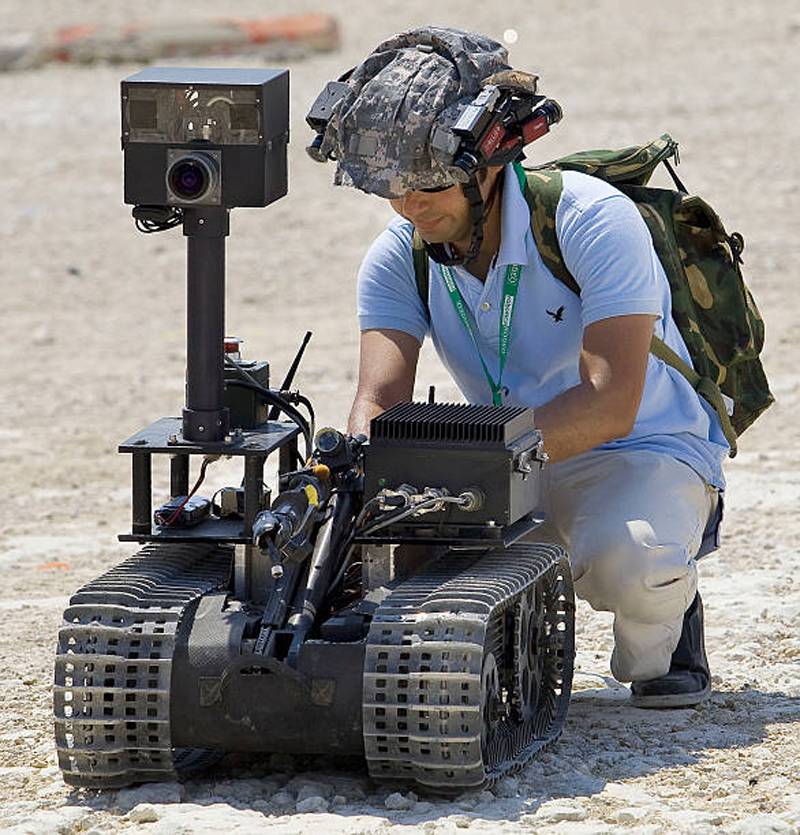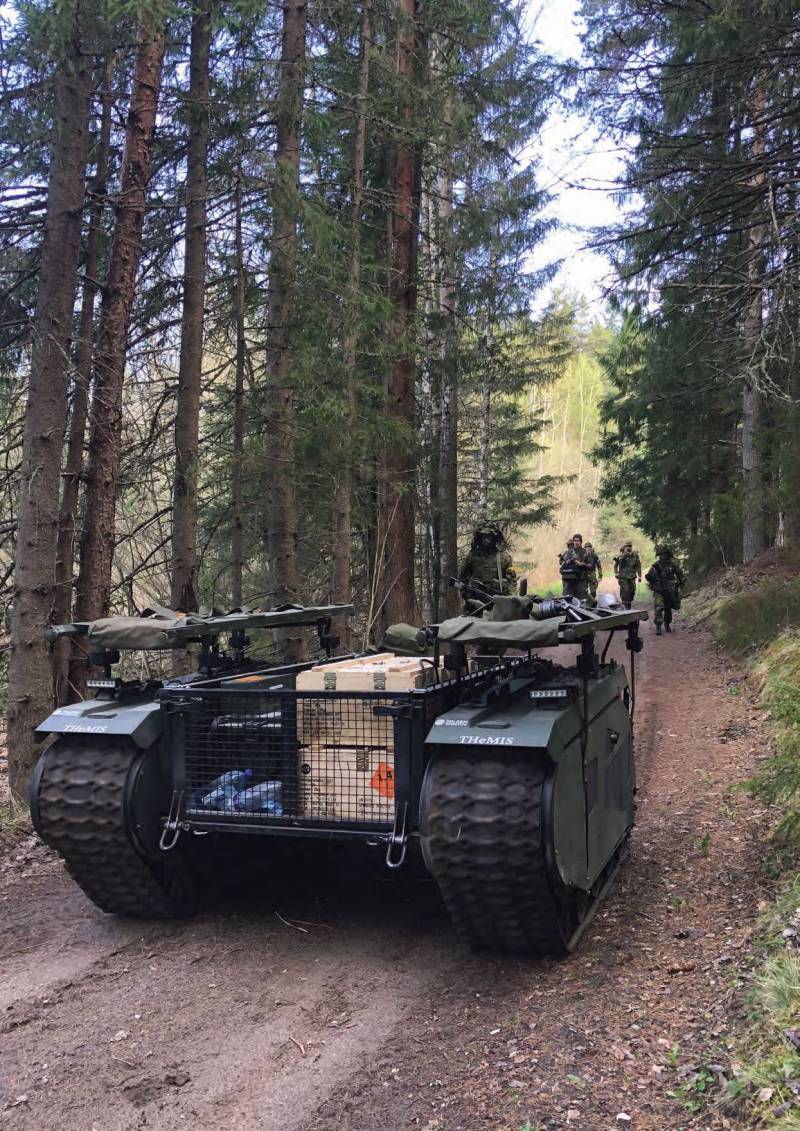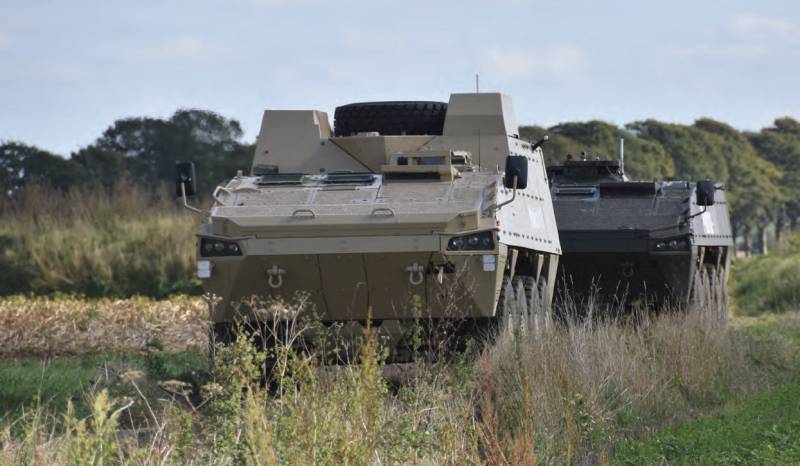View of the European Defense Agency on autonomous systems: concepts and perspectives. Part of 1
Ground-based weapons systems with autonomous functions have proven themselves in the armed forces, which use them in various tasks, including the protection of soldiers or field camps. Their technological potential is significant, however, as well as the challenges they face.
Autonomy of land mobiles robots today is still limited to simple functions like "follow me" or navigation to intermediate coordinates
The most famous class of systems with autonomous functionality, currently deployed by the armed forces of some countries, are active defense systems (SAZ) for armored vehicles, which are able to independently destroy attacking anti-tank missiles, unguided missiles and projectiles. SAZs, as a rule, are a combination of radar or infrared sensors that detect attacking devices with a fire control system that monitors, evaluates and classifies a threat.
The whole process from the moment of detection to the moment of shooting off the counter-projectile is completely automated, since human intervention can slow it down or make timely activation completely impossible. The operator is not just physically unable to give a command to shoot the counter-shells, he will not even be able to control the individual phases of this process. However, SAZ is always programmed in advance in such a way that users can predict the exact circumstances under which the system should react, and under what not. The types of threat that will trigger an SAZ reaction are known in advance or at least predictable with a high degree of confidence.
Similar principles also determine the functioning of other autonomous ground-based weapons systems, for example, intercept systems of unguided rockets, artillery shells and mines used to protect military bases in combat zones. Both SAZ and interception systems can thus be considered as autonomous systems that, after activation, do not require human intervention.
Challenge: autonomy for ground mobile robots
To date, ground-based mobile systems are usually used to detect explosive objects and neutralize them, or reconnaissance of terrain or buildings. In both cases, the robots are remotely controlled and controlled by operators (although some robots can perform simple tasks, such as moving from point to point without constant human assistance). “The reason why human participation remains very important is that ground mobile robots encounter enormous difficulties in independent actions in a complex and unpredictable terrain. Operate a car moving independently around the battlefield, where it must avoid obstacles, drive around with moving objects and be under enemy fire. much more difficult due to unpredictability, than using autonomous weapon systems, such as the aforementioned SAZ, ”said Marek Kalbarchik of the European Defense Agency (EAO). Therefore, the autonomy of ground-based robots today is still limited to simple functions, for example, “follow me by sa” and navigation along given coordinates. The “follow me” function can be used by either crewless machines to follow another vehicle or soldier, while navigating through intermediate points allows the vehicle to use coordinates (determined by the operator or stored by the system) to reach the desired destination. In both cases, the crewless machine uses GPS, radar, visual or electromagnetic signatures or radio channels to follow the lead or along a certain / memorized route.
The choice of a soldier
From an operational point of view, the purpose of using such autonomous functions is usually the following:
• reducing the risk to soldiers in hazardous areas by replacing drivers with unmanned vehicles or unmanned driving kits with autonomous transfer function in transport convoys, or
• providing support to troops in remote areas.
Both functions, by and large, rely on the so-called “obstacle avoidance” element to prevent collisions with obstacles. Due to the complex topography and shape of individual areas of the terrain (hills, valleys, rivers, trees, etc.), the point navigation system used in ground platforms must include a laser radar or lidar (LiDAR - Light Detection And Ranging) or able to use pre-loaded maps. However, since the lidar relies on active sensors and, therefore, it is easy to detect, the emphasis in research is currently placed on passive visualization systems. Although preloaded maps are sufficient when unpacked machines operate in well-known environments for which detailed maps are already available (for example, monitoring and protecting borders or important infrastructure facilities). However, every time when ground robots must enter a difficult and unpredictable space, a lidar is extremely necessary for navigating through intermediate points. The problem is that the lidar also has its limitations, that is, its reliability can be guaranteed only for unmanned machines operating in relatively simple terrain.
Therefore, further research and development is needed in this area. To this end, several prototypes have been developed to demonstrate technical solutions, for example, ADM-H or EuroSWARM, in order to explore, test and demonstrate more advanced functions, including autonomous navigation or crewless system cooperation. These samples, however, are still at an early stage of research.

There are many difficulties ahead
Limitations of lidar are not the only problem faced by ground mobile robots (NMR). According to the study “Fit into the Area and Integration of Unmanned Ground Systems”, as well as the study “Identification of all basic technical and safety requirements for military unmanned vehicles when operating in a combined mission with habitable and uninhabited systems” (SafeMUVe) funded by the European Defense Agency , challenges and opportunities can be broken down into five different categories:
1. Operational: There are many potential tasks that can be considered for ground mobile robots with autonomous functions (communications center, observation, reconnaissance of zones and routes, evacuation of the wounded, reconnaissance of weapons of mass destruction, following the lead with cargo, escorting during transport, clearing routes, etc. .), but there are still no operational support concepts for all of this. Thus, for developers of ground mobile robots with autonomous functions, it is difficult to develop systems that will exactly meet the requirements of the military. Organizing forums or working groups of users of unmanned machines with autonomous functions could solve this problem.
2. Technical: The potential advantages of an NMR with autonomous functions are quite significant, but there are technical obstacles that still need to be overcome. Depending on the intended task, NMRs can be equipped with various on-board equipment sets (sensors for reconnaissance and surveillance, or monitoring and detection of weapons of mass destruction, manipulators for handling explosives or weapon systems, navigation and guidance systems), information collection kits, operator control kits and control equipment . This means that some breakthrough technologies, such as decision-making / cognitive computing, human-machine interaction, computer visualization, battery technologies, or joint information gathering, are essential. In particular, the unstructured and contested surrounding space greatly complicates the work of the navigation and guidance system. Here, it is necessary to move towards the development of new sensors (thermal neutron detectors, interferometers based on supercooled atom technology, intelligent actuators for monitoring and control, advanced electromagnetic induction sensors, infrared spectroscopes) and techniques, for example, decentralized and joint SLAM (Simultaneous Localization and Mapping - simultaneous localization and mapping) and three-dimensional survey of the terrain, relative navigation, advanced integration and integration of data from cash sensors, as well as the provision of p mobility by means of technical vision. The problem is not so much technological nature, since most of these technologies are already used in the civil sphere, as in the regulatory framework. Indeed, such technologies cannot be immediately used for military purposes, since it is necessary to adapt them to specific military requirements.
This is precisely the goal of the OSRA Integrated Strategic Research Program, developed by the ENA, which is a tool that can provide the necessary solutions. As part of OSRA, several so-called technological building blocks or Technology Building Block are being developed, which should eliminate technological gaps associated with ground-based robots, for example: joint actions of habitable and uninhabited platforms, adaptive interaction between humans and a non-boxing system with different levels of autonomy; monitoring and diagnostic system; new user interfaces; navigation in the absence of satellite signals; autonomous and automated guidance, navigation and control and decision-making algorithms for crew and crewless platforms; control of several robots and their joint actions; precision guidance and control of weapons; active imaging systems; artificial intelligence and big data for decision making. Each TIA is owned by a special group or CapTech, which includes experts from the government, industry and science. The task of each CapTech group is to develop a roadmap for their TVB.
3. Regulatory / Legal: A significant obstacle to the implementation of autonomous systems in the military sphere is the lack of suitable verification and evaluation techniques or certification processes that are necessary to confirm that even a mobile robot with the most basic autonomous functions is able to work correctly and safely even in a hostile and complex environment. In the civilian sphere, unmanned vehicles face the same problems. According to the SafeMUVe study, the main lag defined in relation to specific standards / best practices is in modules related to a higher level of autonomy, namely “Automation” and “Data fusion”. Such modules as, for example, “Perception of the external environment”, “Localization and mapping”, “Supervision” (Decision Making), “Traffic Planning”, etc., are still at the average levels of technological readiness and, although there are several decisions and algorithms designed to perform various tasks, but no standard is not yet available. In this regard, there is also a lag regarding the verification and certification of these modules, partly solved by the European initiative ENABLE-S3. The newly established network of testing centers of the EAU was the first step in the right direction. This allows national centers to implement joint initiatives in order to prepare for testing promising technologies, for example, in the field of robotics.
AMV armored vehicles during the testing of autonomous vehicles on the ELROB 2018 (the AMV 8x8 version with a raised roof should be followed by a stand-alone Patria AMV)
4. Personnel: Expanded use of unmanned and autonomous ground systems will require changes in the military education system, including in the training of operators. Military personnel, first of all, need to understand the technical principles of system autonomy in order to properly operate and control it, if necessary. Creating trust between the user and the autonomous system is a prerequisite for wider use of ground systems with a higher level of autonomy.
5. Financial: While global commercial players like Uber, Google, Tesla or Toyota are investing billions of euros in the development of unmanned vehicles, the military is spending much more modest sums on unmanned ground systems that are also distributed among countries that have their own national development plans for such platforms. The European Defense Fund being established should help consolidate funding and support a collaborative approach to the development of ground mobile robots with more advanced autonomous functions.
The work of the European Agency
For several years, the EAU has been active in the field of ground mobile robots. Specific technological aspects, such as mapping, route planning, following the lead, or circumventing obstacles, have been developed in collaborative research projects such as the SAM-UGV or HyMUP; both funded jointly by France and Germany.
The SAM-UGV project aims to develop a stand-alone sample demonstration of technologies based on a mobile ground-based platform, which is distinguished by the modular architecture of both hardware and software. In particular, the sample technology demonstration confirmed the concept of scalable autonomy (switching between remote control, semi-autonomy, and fully autonomous mode). The SAM-UGV project was further developed in the framework of the HyMUP project, which confirmed the possibility of performing combat missions with uninhabited systems in coordination with existing manned machines.
In addition, the protection of autonomous systems from deliberate interference, the development of security requirements for mixed tasks and the standardization of NMR are currently being addressed, respectively, in the framework of the PASEI project and SafeMUVe and SUGV studies.
On and under water
Automatic sea systems are a key component of the modernization and transformation of the naval forces, they can drastically change the structure and paradigm of actions of technologically advanced fleets, which will allow them to become a more dynamic force that responds more quickly to an ever-expanding range of threats.
Automatic Maritime Systems (AMS) have a significant impact on the nature of hostilities, and everywhere. The wide availability and cost reduction of components and technologies that can be used in military systems allow an increasing number of state and non-state actors to gain access to the waters of the world's oceans. In recent years, the number of exploited AMCs has increased several times and therefore it is imperative that relevant programs and projects be implemented that provide the fleets with the necessary technologies and capabilities to ensure safe and free navigation in the seas and oceans.
The influence of completely autonomous systems is already so strong that any sphere of defense that will miss this technological breakthrough will also miss the technological development of the future. Bezkipazhnye and autonomous systems can be used with great success in the military sphere to perform complex and tough tasks, especially in hostile and unpredictable conditions that the marine environment clearly illustrates. The marine world is easily challenged, it is often missing from maps and difficult to navigate, and these autonomous systems can help overcome some of these challenges. They have the ability to perform tasks without direct human intervention, engaging modes of operation, due to the interaction of computer programs with external space.
It is safe to say that the use of AMC in maritime operations has the broadest prospects, and all “due to” hostility, unpredictability and size of sea space. It is worth noting that the irrepressible thirst for conquering marine spaces, combined with the most complex and advanced scientific and technological solutions have always been the key to success.
AMCs are becoming increasingly popular with seafarers, becoming an integral part of fleets, where they are mainly used in non-lethal missions, for example, in anti-mine warfare, for reconnaissance, observation and information gathering. But autonomous marine systems have the greatest potential in the underwater world. The underwater world is becoming the scene of increasingly fierce disputes, the struggle for marine resources is intensifying, and the need for ensuring the safety of maritime communications is high.
Продолжение следует ...


Information